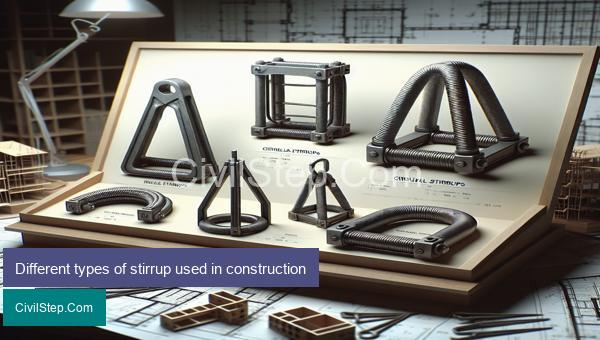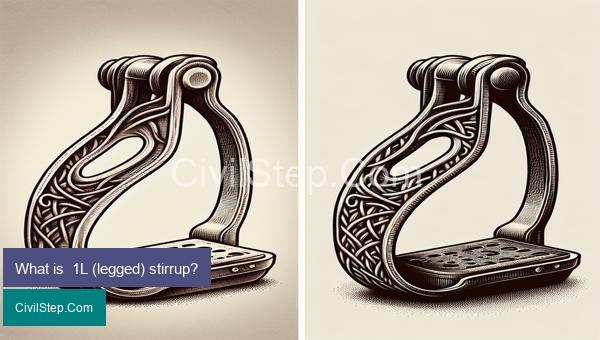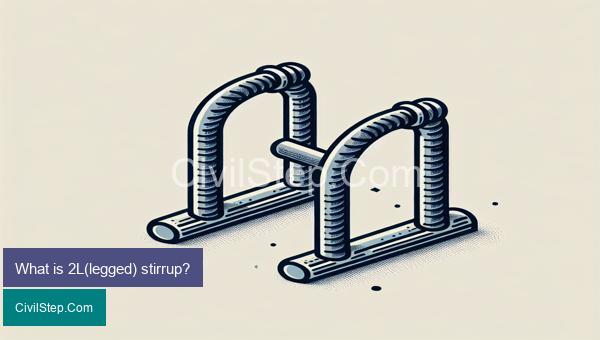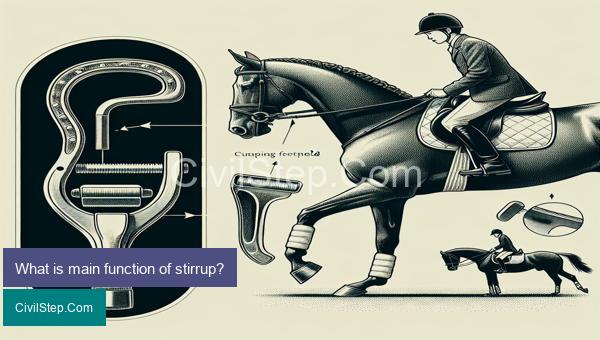
Stirrups are an essential component in the construction of reinforced concrete structures. They are small but mighty reinforcements that play a crucial role in enhancing the overall strength and durability of a building. Despite their small size, stirrups come in various types and designs depending on their intended use and structural requirements. In this article, we will delve into the different types of stirrups used in construction and their specific purposes. Understanding the various types of stirrups is essential for construction professionals and enthusiasts alike, as it directly affects the safety and stability of the structures we build.
Different types of stirrup used in construction

Stirrups are an important component used in reinforced concrete construction. They are used to provide lateral support and prevent shear failure in beams and columns.
There are different types of stirrups used in construction based on their shape, size, and purpose. Let’s take a look at some of the most commonly used stirrups in construction:
1. Rectangular Stirrups: These are the most basic type of stirrups and are commonly used in construction. They are made of mild steel and have a rectangular shape with rounded corners. They are used in beams and columns to provide support and resist shear forces.
2. Circular Stirrups: These stirrups have a circular shape and are used in columns and beams. They provide better confinement to the concrete and increase its load-bearing capacity.
3. Helical Stirrups: These stirrups have a helical shape and are used in circular columns. They provide better stability and increase the strength of the column.
4. Twisted Stirrups: These stirrups have a twisted shape and are commonly used in beams. They provide better resistance to shear forces and are suitable for high-stress areas.
5. C-shaped Stirrups: These stirrups are named after their shape, which resembles the letter ‘C’. They are used in short columns and provide better confinement to the concrete.
6. Stirrup Bolsters: These are short pieces of rebar bent into a U-shaped or L-shaped configuration. They are used to hold the vertical reinforcement bars in place during construction.
7. Anchor Stirrups: These stirrups are used to anchor the bottom reinforcement in a column. They are U-shaped and are placed at the bottom of the column.
8. Zigzag Stirrups: These stirrups have a zigzag shape and are used in beams. They provide better resistance to shear and increase the load-carrying capacity of the beam.
In addition to these types, there are also specialized stirrups used in construction, such as seismic stirrups, composite stirrups, and column/beam-ring stirrups.
It is important to choose the right type of stirrup based on the structural design and the load-bearing capacity required for the construction. The size and spacing of the stirrups must also be carefully calculated to ensure the structural integrity of the building.
In conclusion, stirrups are an essential element in reinforced concrete construction. They provide lateral support and increase the load-bearing capacity of beams and columns. Different types of stirrups are used in construction depending on their shape, size, and purpose. It is crucial to select the appropriate stirrup for a particular project to ensure the strength and stability of the structure.
What are different shape of stirrup used in construction work

Stirrups are reinforcement bars used in reinforced concrete structures to provide additional support and strength. They are typically placed perpendicular to the main reinforcement bars to hold them in place and prevent them from buckling or bending. Stirrups are available in different shapes and sizes to meet the specific design requirements of construction projects. In this article, we will discuss the different shapes of stirrups used in construction work.
1. Rectangular stirrups
Rectangular stirrups, also known as rectangular ties, are the most commonly used stirrup shape. They are made by bending a straight bar in a rectangular shape with 90-degree angles at the corners. The main advantage of rectangular stirrups is their flexibility in use as they can be used for any type of reinforcement size and spacing. They are widely used in beams, columns, and slabs.
2. Square stirrups
Square stirrups, as the name suggests, have a square shape and are made by bending a straight bar at right angles. The main advantage of square stirrups is that they provide more torsional strength than other stirrup shapes. Therefore, they are often used in structures with high torsional loads, such as bridge piers and columns.
3. Circular stirrups
Circular stirrups, also known as hoop ties, are made by bending the reinforcement bar into a circular shape. They are commonly used in curved structures, such as domes, arches, and circular columns. Circular stirrups provide better confinement of concrete and improve the ductility of the structure.
4. Helical stirrups
Helical stirrups are made by bending a straight bar into a helical shape. They are widely used in circular structures and are particularly useful for increasing the shear strength of columns and piers. Helical stirrups also provide better confinement of concrete and improve the structural integrity of the column.
5. U-shaped stirrups
U-shaped stirrups, also known as hairpin ties, are made by bending the reinforcement bar into a U shape with hook-shaped ends. They are mainly used in columns to provide extra support and ensure proper confinement of the concrete. U-shaped stirrups are also used in shear walls to resist lateral loads.
6. Zigzag stirrups
Zigzag stirrups are made by twisting a straight bar into a zigzag shape. They are used in structures that are subjected to seismic loads as they provide better ductility and energy absorption. Zigzag stirrups are also used in slabs to increase their shear strength.
7. Diagonal stirrups
Diagonal stirrups, also known as inclined stirrups, are made by bending the reinforcement bar at an angle to provide diagonal support to the main reinforcement. They are used in beams, slabs, and columns to resist diagonal shear forces and improve the overall structural stability.
In conclusion, stirrups are an essential component of reinforced concrete structures and play a vital role in strengthening and supporting the structure. The selection of stirrup shape depends on the type and size of the structural element, as well as the design requirements. Civil engineers must carefully consider the structural requirements and select the appropriate stirrup shape to ensure the safety and durability of the structure.
What are uses of stirrup?

Stirrups are an important component in reinforced concrete structures, commonly seen in beams and columns. They are typically made of steel and are bent in a U-shape, with straight ends that are embedded into the concrete. The main function of stirrups is to provide lateral support and prevent the vertical bars from buckling due to compression.
Here are some of the uses of stirrups in civil engineering:
1. Enhance structural strength: Stirrups play a crucial role in adding strength to reinforced concrete structures. They help in distributing the load evenly and resisting bending and shearing forces, thereby increasing the strength and durability of the structure.
2. Improve earthquake resistance: Earthquakes exert lateral forces on buildings which can lead to their collapse. Stirrups are designed to provide resistance against these lateral forces, making the structure more earthquake-resistant.
3. Prevent concrete cracks: One of the main causes of concrete cracks is the thermal expansion and contraction of concrete due to temperature variations. Stirrups help in controlling the size of these cracks by holding the steel reinforcement in place, thus minimizing the impact of thermal changes.
4. Control deflection: When there is a heavy load on a structure, it tends to deflect or bend. Stirrups help in controlling the deflection and maintaining the structural stability by reinforcing the beams and columns.
5. Reinforce beams and columns: Stirrups are commonly used to reinforce the horizontal and vertical walls of beams and columns. They help in maintaining the shape and size of these elements and providing the required strength to withstand external loads.
6. Ensure structural safety: Stirrups are essential for the safety of a structure. They prevent the columns and beams from buckling or collapsing due to the applied loads, thus ensuring the safety of the building and its occupants.
7. Facilitate construction process: The use of stirrups makes the construction process smoother and more efficient. They are prefabricated and can be easily installed, reducing the time and labour required for construction.
8. Increase load-carrying capacity: Stirrups increase the load-carrying capacity of beams and columns by enhancing their strength and stiffness. This is particularly important in high-rise buildings, where the structural elements are exposed to high loads.
In conclusion, stirrups play a crucial role in the stability and strength of reinforced concrete structures. They are essential for ensuring the safety and durability of buildings and enhancing their load-carrying capacity. Without stirrups, reinforced structures would be prone to failure and collapse under heavy loads and external forces. Therefore, it is important to ensure that stirrups are properly designed and installed in any reinforced concrete structure.
What is meaning of L in stirrup

In civil engineering, stirrups are essential reinforcement elements used to provide strength and stability to concrete structures. They are commonly used in columns, beams, and other load-bearing elements to resist lateral pressures and prevent diagonal cracking. Stirrups are typically made of steel, and their configuration can greatly impact the overall structural integrity of a building.
The “L” in stirrup refers to the shape or configuration of the reinforcement element. It is named L-stirrup due to its resemblance to the letter L in its shape. L-stirrups are one of the most commonly used types of stirrups in reinforced concrete structures.
The purpose of stirrups is to help distribute the load evenly and prevent the longitudinal bars (also known as main bars) from buckling under stress. L-stirrups are placed in a vertical position along the longitudinal bars and are then tied to the bars with a binding wire. The size and spacing of stirrups depend on the design of the structure and the magnitude of the external forces it will encounter.
L-stirrups are designed to provide excellent resistance against diagonal tension forces, which are a common cause of cracking in reinforced concrete structures. The shape of the stirrup allows it to fully encircle the longitudinal bars, providing sufficient support to resist these forces. This helps to prevent the formation of cracks and ensure the durability and stability of the structure.
In addition to providing diagonal resistance, L-stirrups also help to control the spacing and alignment of longitudinal bars. They hold the bars in place during concrete pouring and ensure that they stay in the correct location and orientation. This prevents the bars from moving or shifting during the consolidation process, which could lead to a weaker and less stable structure.
In conclusion, the “L” in stirrup stands for the shape of the reinforcement element, which is crucial in providing strength and stability to reinforced concrete structures. L-stirrups play an essential role in preventing diagonal cracking and ensuring the durability of buildings and other structures. Their use and proper positioning are crucial in the construction industry to ensure the safety and reliability of our built environment.
What is 1L (legged) stirrup?

A 1L stirrup, also known as a one-legged stirrup, is a type of reinforcing steel bar used in the construction of concrete structures. It is a U-shaped, bent piece of steel that is placed vertically throughout the length of a concrete column or beam. The term “1L” refers to the single leg of the stirrup, which is typically formed by bending a straight reinforcement bar at a right angle.
One-legged stirrups are primarily used to provide lateral support and prevent shear failure in reinforced concrete members. They work in conjunction with horizontal reinforcement bars, such as steel beams or columns, to create a sturdy and durable structure.
The unique shape and placement of 1L stirrups offer several advantages in the construction of concrete structures. They provide better confinement of concrete, increasing its strength and ductility. They also help in distributing the stress more evenly throughout the structure, reducing the chances of brittle failure.
Moreover, the use of 1L stirrups allows for more flexibility in terms of column and beam sizes, as they can be easily modified to fit different dimensions and configurations. This also makes them a cost-effective solution for construction projects.
The installation of 1L stirrups follows a specific process. First, the vertical reinforcement bars are placed in the formwork, followed by the horizontal bars. The 1L stirrups are then hung onto the lower horizontal bars, and the concrete is poured to fill the form. After the concrete has set, the formwork is removed, revealing a robust and reinforced structure.
It is crucial to ensure that the 1L stirrups are properly spaced and securely tied to the horizontal reinforcement bars to provide effective reinforcement. During construction, it is essential to follow the design specifications and codes to ensure the stirrups are placed correctly.
In conclusion, 1L stirrups play a vital role in reinforcing concrete structures and ensuring their stability and durability. They are a crucial element in the construction process and require careful planning, placement, and installation to provide effective reinforcement.
What is 2L(legged) stirrup?

A 2L stirrup, also known as a two-legged stirrup, is a structural reinforcement commonly used in concrete beams and columns. It consists of two legs that are placed perpendicular to each other and connected by a transverse bar. The shape of this reinforcement resembles the letter “L”, hence the name 2L stirrup.
The primary function of a 2L stirrup is to resist the shear forces and increase the flexural strength of a concrete member. These forces are generated due to the weight and external loads acting on the structure, which can cause the beam or column to bend and deform. The two legs of the stirrup provide support and prevent the concrete from cracking or failing under these forces.
To understand the significance of the 2L stirrup, it is essential to understand the behavior of concrete under different loads. When a beam or column is subjected to a vertical load, the top part experiences compressive stress, while the bottom part experiences tensile stress. As a result, the concrete at the bottom will tend to crack and fail due to the tensile forces. To prevent this, steel reinforcements, such as 2L stirrups, are used.
The 2L stirrup is designed to resist both the vertical and horizontal shear forces, which occur due to the bending of the beam or column. The transverse bar connects the two legs, providing resistance against the vertical shear, while the two legs resist the horizontal shear forces. This reinforcement combination makes the concrete member stronger and more durable.
When designing a reinforced concrete structure, the spacing, size, and number of 2L stirrups are essential factors to consider. The spacing between two stirrups should be such that they effectively transfer the shear forces and prevent excessive deflection, thereby maintaining the structural integrity. The size and number of stirrups required depends on the magnitude of load and the dimensions of the concrete member.
In conclusion, the 2L stirrup is a vital structural reinforcement in the field of civil engineering. It reduces the risk of failure and increases the load-carrying capacity of concrete beams and columns. Proper installation and design of 2L stirrups play a crucial role in ensuring the overall safety and durability of a structure.
What is main function of stirrup?

Stirrups are an essential component in reinforced concrete structures, which are widely used in construction projects due to their strength, durability, and versatility. One of the main functions of stirrups is to provide lateral support and increase the flexural strength of reinforced concrete beams and columns.
In reinforced concrete beams, stirrups are placed perpendicular to the longitudinal steel bars, known as “main bars.” These stirrups encircle the main bars, forming a closed structure, often referred to as a “stirrup cage.” When the beam is subjected to a bending load, the top portion of the beam is in compression, while the bottom portion is in tension. The stirrups play a crucial role in resisting the tension forces, preventing the concrete from cracking and the beam from failing.
Similarly, in reinforced concrete columns, stirrups are placed vertically around the main bars to prevent the concrete from buckling under compression. With the help of stirrups, the column can withstand lateral loads, such as wind and earthquake forces, and remain stable.
Apart from providing lateral support and increasing flexural strength, stirrups also help in controlling the size and spacing of the main bars. In beams, stirrups maintain a minimum spacing between the main bars, ensuring effective distribution of loads and preventing overcrowding. They also help to keep the main bars in their designated positions during construction, ensuring proper alignment and providing reinforcement continuity.
In addition to their primary functions, stirrups also enhance the overall ductility and toughness of reinforced concrete structures. Ductility refers to the ability of a material to deform before failure, whereas toughness is its ability to absorb energy during deformation. Stirrups improve both these properties, making reinforced concrete structures more resilient to extreme loading conditions.
In conclusion, the main function of stirrups in reinforced concrete structures is to provide lateral support, increase flexural strength, control spacing and alignment of main bars, and improve ductility and toughness. Therefore, it is crucial to ensure the proper design, placement, and detailing of stirrups for safe and efficient construction of reinforced concrete elements.
Conclusion
In conclusion, understanding the different types of stirrups used in construction is crucial for ensuring the structural integrity and safety of a building or infrastructure. From traditional stirrups to advanced composite stirrups, there are various options available depending on the specific needs and requirements of a project. Each type offers unique advantages and should be chosen carefully based on the design, budget and desired outcome. As technology and materials continue to advance, we can expect to see even more innovative stirrup designs being used in construction. By staying informed and educated about these different types of stirrups, we can ensure that our construction projects are strong, durable and built to last.
